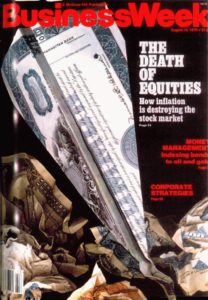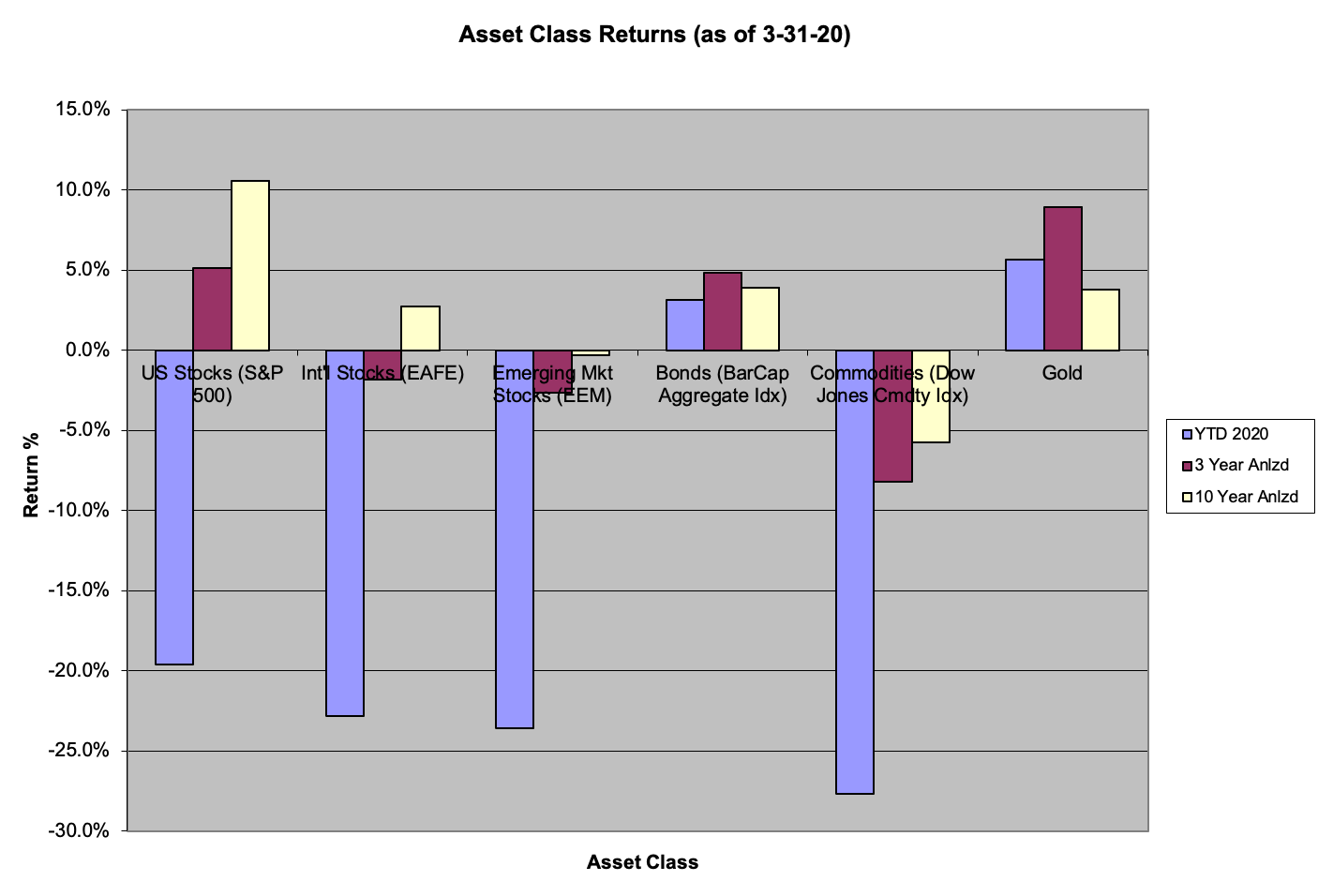You make most of your money in a bear market; you just don’t realize it at the time.
-Famed value investor Shelby Davis.
The COVID19 induced market panic led to the quickest Bear Market (loosely defined as a drop of more than 20% from market highs) in modern history. In only 20 days markets went from all-time highs to Bear Market territory. As we wrote in an interim market update in March, markets HATE uncertainty and COVID19 has provided plenty of uncertainty for markets to digest.
The question on most investors’ minds right now is how to move forward amidst an unprecedented health crisis, looming recession, and Bear Market in stocks. For this reason, we will focus this letter almost exclusively on Bear Market strategy. Before diving in to strategy, it is important to further refine our definition of what constitutes a Bear Market.
While price decline makes for an easy way to measure a Bear Market (i.e. down 20% from highs), price decline alone does not really get at the true nature of a Bear Market. If price decline alone constituted a Bear Market then the dips of nearly 20% in both 2011 and 2018 would have been harbingers of a Bear Market. But rapid recoveries to new all-times in both instances meant that these were simply just corrections in an ongoing Bull Market.
Duration – Frustration – Capitulation – Recovery
DURATION
We can best describe a real Bear Market as a progression of events. First, a Bear Market must have duration. In short, this means that it goes on for a period of time longer than anyone expected. According to Bloomberg News, since 1927 there have been 14 separate Bear Markets for the S&P 500. The below chart provides a look at the duration and depth of past Bear Markets by percentile. The current downturn highlighted in blue stands out both in terms of the speed of the decline and the limited duration thus far.
At only ~40 days old, this Bear Market likely has some duration left in it. Stock market rallies are normal in Bear Markets, and while the recent rally from the lows of March could be signaling the imminent end of this Bear Market, we do not think this is likely. Both corporate earnings and gross domestic product are expected to take a massive hit in the coming quarters. While the market has likely priced some of this in, there is simply too much uncertainty and too much potential economic damage yet to be digested to assume only sunny skies for the foreseeable future.
FRUSTRATION
The duration of the typical Bear Market wears down investors, which leads to frustration. This leads to an insidious psychological trap where investors find themselves in a feedback loop of negative news/data followed by selling pressure and unrealized (at first) portfolio losses. Bear Market rallies occur where prices rise for a period of time, only to be met again with more bad news and renewed selling pressure.
CAPITULATION
Finally, the frustration of seemingly never-ending losses leads to capitulation. Previously stoic investors who believed both in the businesses that they were invested in, and indeed the broader capitalist system, throw in the towel and sell. Ultimately realizing portfolio losses.
The Business Week cover from August 1979 heralding the “Death of Equities” is a famous historical example of capitulation. While markets did not immediately bottom following this publication, the capitulation that it unwittingly foreshadowed led ultimately to recovery and a ten year period where stocks produced annual returns of more than 12% per year, nearly tripling their levels from the ’79 publication date.
Risk Management
One of the biggest misconceptions of portfolio risk management is that one must take action to stop losses and manage risk when a Bear Market rears its head. The reality is that risk management should be implemented before, not during a Bear Market. This is done via the development of an appropriate asset allocation strategy (mix of stocks, bonds, real estate, and other diversifying assets) for your age, time horizon and risk tolerance. Periodic portfolio rebalancing via taking profits in appreciated assets, and buying those assets that have declined helps to compliment the overall strategic allocation.
However, when volatility spikes and unrealized losses hit a portfolio, it can be very difficult for investors to maintain their composure. The thoughtful and well implemented asset allocation strategy will experience unrealized losses and the temptation to take action can overwhelm even the most rational and seasoned investor. It is at this point that the real risk of a Bear Market is at its apex: The investor in assets decides to become a speculator in asset prices.
The investor turned speculator story typically does not end well as these are two very different skill sets. At AMM we are investors of our clients’ assets. We focus primarily on financial assets (stocks, bonds, real-estate, and other asset backed securities), and seek to invest at prices that make economic sense and hold these assets with the goal of benefitting from ongoing dividends and long-term capital appreciation.
Aside from the periodic portfolio rebalancing described above, we will generally only sell an asset when 1) there has been a significant fundamental change in the underlying asset that causes us to change our investment thesis (e.g. a portfolio holding cuts its dividend), 2) we need to raise cash to fund a new more attractive investment, or 3) there is been a fundamental change to our client’s circumstances which requires a portfolio strategy change.
Our reasons for selling do not include “when prices decline”, or to “manage risk” when markets begin to sell off as this would make us speculators; making investment decisions based on the price action of the asset and not the asset itself.
Bear Market Strategy
None of this is to suggest that investors should sit idly by and take no action during Bear Markets. In fact, as the quote at the top of this communication suggests, Bear Markets are ripe with opportunity to improve long-term returns. Below we highlight some key Bear Market strategies that we seek to deploy for clients where appropriate to their specific circumstances:
Focus on Quality
Bear Markets may provide an opportunity to trade up in quality. While AMM generally focuses on quality in our investment process, it can be challenging to buy higher quality stocks at fair prices in a raging Bull Market. Most market participants recognize the quality too, which bids up the price of the stock, often making it too expensive for a value conscious investor. When a severe Bear Market hits, there is a “throw the baby out with the bathwater” mentality where all stocks sell off regardless of quality. This can be an opportunity to reconfigure portfolio assets in to higher quality stocks at more attractive prices.
Buy Low, But Not All at Once
The good news is that all Bear Markets have a silver lining in that they set the stage for a future recovery. The key is to not wipe out in the interim, whether through capitulation or under the more benign banner of “managing risk” (i.e. selling otherwise good assets to avoid further price declines). When markets eventually recover, the investor who capitulated is unlikely to quickly re-risk their portfolio and participate in the upside.
Instead, we look to Bear Markets as potential buying opportunities, but we recognize we do not know the exact bottom. Drawing from our experience in past Bear Markets, we seek to use the duration of the Bear Market to buy at various levels throughout the bearish environment. This allows us to leg in to positions at more favorable prices over time.
Tax Loss Harvesting
Bear Markets provide investors the opportunity to strategically “harvest” losses from their portfolios. The securities sold at a loss can be replaced by a similar but not identical security, so the portfolio will participate in a market rebound. Losses can be used to offset future capital gains and/or a portion (currently $3,000/year) can be used as a deduction against income.
Over-allocate to Risk Assets
This is the equivalent of “turning in to the crash” as your car swerves on a slippery road. It may feel counterintuitive at the time, but by overweighting your portfolio to stocks as a Bear Market progresses, investors can set themselves up for greater upside once a more sustainable recovery takes hold.
Q1 Review & Economic Outlook
Through March 31, 2020.
- Domestic stocks (S&P 500) declined -19.6%
- Developed international stocks (EAFE) declined -22.8%
- Emerging market stocks (EM) were down -23.6%
- Bonds (Bar Cap Agg Idx) increased 3.2%
- Commodities were down -27.7%
- Gold increased 5.6%.
We have updated our asset class return chart below:
Given the unparalleled shutting down of huge parts of the global economy, it should be no surprise that economists have been rapidly revising their estimates for GDP growth downward for 2020. J.P. Morgan has slashed their 2Q GDP growth estimate to -40%, and has suggested that unemployment could approach 20% in the month of April. While these are without a doubt Depression level readings, markets are currently looking past these largely expected negative numbers, to an expected rebound in the second half of the year.
With a new and rapidly evolving economic crisis, there are many views about how this may play out. The most bullish possible outcome would be a V shaped recovery, whereby the economy opens up relatively soon and a vast majority of sidelined workers are re-employed quickly. A more moderate, and increasingly likely outcome is the U shaped recovery whereby there is a “fall, a stall, and surge”. The most negative outcome would be the dreaded L shaped outcome – which is to say no recovery for the foreseeable future.
The actions by policy makers, notably the Federal Reserve, have helped cushion the potential economic blow. There is sure to be debate in future years on whether they have gone too far in their unconventional support of the economy, including the purchase of both investment grade and below investment grade corporate bonds. But the time for debate is not now. In the words of the Fed Chairman Jerome Powell, “we will continue to use these powers forcefully, proactively, and aggressively until we are confident that we are solidly on the road to recovery”. He went even further, summing up the feelings of many who have had their economic lives blindsided by the virus, “We should make them whole. They did not cause this.”
While the likelihood of an L outcome is not zero, we remain firmly of the view that a more moderate U shaped recovery is the most likely. Given that the COVID crisis is new, there is no easy way to handicap how consumer behavior may or may not change, and how a short but deep recession may affect the willingness of individuals and corporations to spend and invest. But we think the powerful policy response from the Federal Reserve has helped to buttress the economy from the worst possible outcome. This doesn’t guarantee calm seas ahead in the near-term, but should allow the US economy as a whole to weather this once in a century storm.
In March, we filed the annual amendment of our firm’s ADV brochure dated March 30, 2020 with the securities and Exchange Commission. We can provide you with a full copy of the ADV filing at your request.
Should you have any questions regarding your investment account(s) and personal financial plans, or if there have been any recent changes to your investment and/or retirement objectives, please do not hesitate to contact our office to speak with one of us at your convenience.
As always, we thank you for entrusting AMM to help you achieve your investment and retirement objectives.
Your Portfolio Management Team






